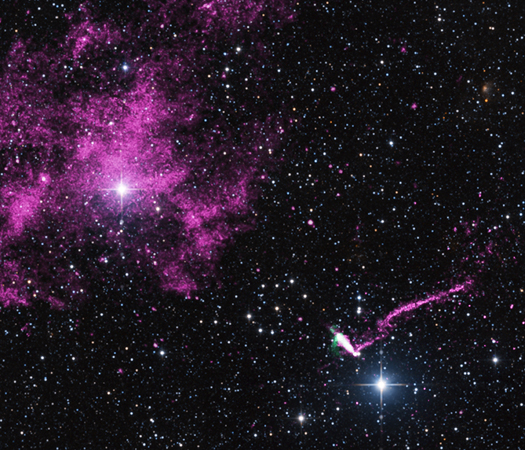Running at Breakneck Speed With Open Arms

Lucia Pavan graduated with a master thesis in astronomy at the University of Padova (the same town from which Galileo discovered Jupiter's moons). Four years later she also got her PhD in Physics at the same university, working on "magnetars" -a particular kind of pulsars, with the highest magnetic fields. After the PhD, she obtained a postdoc position at the University of Geneva - Switzerland, working at the INTEGRAL Science Data Center (ISDC). In between, she moved to the US, working at University of Wisconsin-Madison for a few months. She currently lives in Geneva, working at the ISDC.
When I started to work on the sources discovered by the INTEGRAL satellite, I didn’t expect to find an object that was extraordinary not only for the properties of its emission, but also for its extension and shape in the sky. And yet this was the case when I came across IGR J11014-6103.
INTEGRAL is an ESA satellite in operation since 2002, sensitive mainly to X-ray and gamma-ray bands. The satellite has been accumulating data since the beginning of the mission, providing information on an always-growing number of X-ray emitters. It is thanks to this ability that new objects are continuously discovered. A large fraction of the sources that INTEGRAL has found still lacks any physical classification, a perfect area for new findings to be done.
IGR J11014-6103, which we nicknamed the “Lighthouse nebula” for its X-ray appearance, attracted my attention because of its relative strong emission in the range of the very energetic X-rays that INTEGRAL monitors. But when I found in the archives of the XMM satellite an image that caught the source just by chance, I really got interested on it: that X-ray image showed a surprising shape, very elongated, like a stripe in the sky!
With a team of colleagues from the Integral Science Data Center (ISDC) and Institute for Astronomy and Astrophysics (IAAT) at Tübingen, Germany, we started to work on it. Soon we got the idea that this long stripe shining in X-rays was produced by a “pulsar”, the compact, spinning, core, left after a massive star explodes. But still we didn’t know how this stripe was produced. There are only a couple of similar “stripes” originating from isolated pulsars, and it’s isn’t clear for any of what is the physical mechanism underneath. This object was fascinating, but with the available data we couldn't test our hypotheses. We needed to know more about it, at all possible wavebands. This is the same as we do in every-day life to understand what is an “unknown” object in front of us: we explore it with all our senses, observing, touching it, and so on. We do the same in astrophysics, except that our "senses" in this case are all the different wavelengths of light.
We asked for a new observation in X-rays with Chandra, because of its ability to produce the finest images in X-rays, and in radio waves with the Australia Telescope Compact Array (ATCA), an array of 6 radio antennas that can be moved over a rail of 6 km.
I was at a conference in Paris when, several months later, I finally received the Chandra data of our observation. Even the raw image from Chandra was simply breathtaking. The linear stripe revealed much more details than I expected, there was another -- much fainter -- stripe, going in the opposite direction. The pulsar produces also a short tail, like a sort of “comet” shining in X-rays and in radio waves, and directed almost perpendicularly to the long stripe.
We started to work on the new data together with colleagues from the University of Western Sydney and the University of Rome. It was much more difficult than expected to prove our idea, but with all the multi-wavelength data we collected, we were finally able to conclude that the small comet shape is due to the wind produced by the pulsar, what is called its “pulsar wind nebula”. Its elongated shape is due to the speed of the pulsar, in a similar way that Mach cones are formed by supersonic airplanes. We could also confirm that the pulsar was born some 15000 years ago during the explosion that left over the debris visible just north to it (what is called a supernova remnant), as was suggested by other astronomers with a much shorter Chandra observation (http://chandra.harvard.edu/photo/2012/igrj11014/). The two systems are at the same distance from us (around 20000 light-years), and the long X-ray stripe produced by the pulsar have a huge length of almost 40 light years! The pulsar is traveling since the time of the explosion at an impressive velocity of more than 1000 km/s.
The last, fundamental, piece was much harder to get solved: whether this stripe, so long and energetic, was or not a stream of particles blown away by the pulsar itself (what is called a “jet”). Only when we created a numerical model to simulate different aspects of a jet when seen through Chandra’s eyes, and we compared it to our data, we were finally able to prove that this is indeed a pulsar jet. It is as if the pulsar is running through the interstellar space at an incredible speed, with its two “arms” stretched large, and leaving a wake behind it.
Having proved that the stripe is indeed a pulsar jet, we also got the information on how the axis of rotation of the pulsar is oriented (the jet always lays on the rotation axis, as otherwise the particles projected away could not form a stripe, but rather a disk). This in turns opens up numerous questions, for example on the kind of explosion that have formed this pulsar, which, unexpectedly, was ejected in a direction different from its rotation axis. The supernova remnant is not completely spherical, but rather seem to be distorted by a sort of “bar”, in a direction similar to the pulsar jets. This might suggest that the jets had an important role during the explosion, again a point that will need to be further investigated.
Another important aspect of the jet is that it is forming a helix in space. An immediate interpretation would be that the pulsar is wobbling (what is called free precession), and the helix mirrors the different launching directions of the particles. Several other pulsars (for example the Vela pulsar (http://chandra.harvard.edu/press/13_releases/press_010713.html) ) are sought to wobble as well, but this hypothesis is still argument of debate in the astrophysical community, and another possible hypothesis is that these effects are due instead to instabilities that grow along the jet.
There will be still much more to discover and understand about this source, and about pulsars and jets formation in general –phenomena that are widespread and that here, for the first time, can be studied all at once. We hope that the new data that will arrive soon from Chandra (a much longer observation, equivalent to almost 3 days) and at several different wavelengths (for example in the optical band, with the Very Large Telescope in Chile) will help us unraveling these open questions.
-Lucia Pavan
Subcategory:
- Log in to post comments

